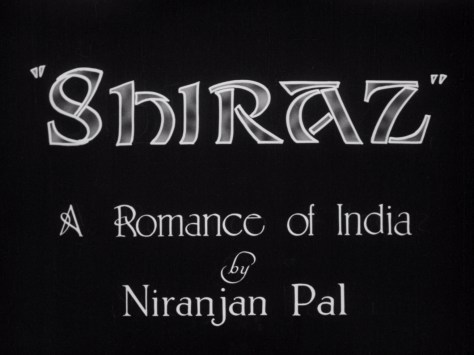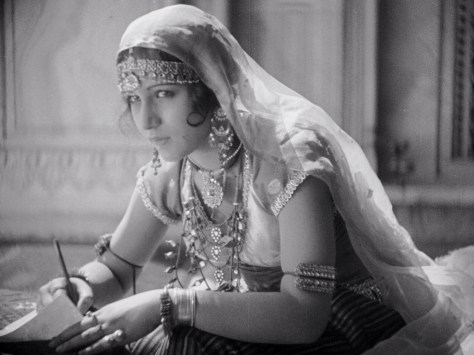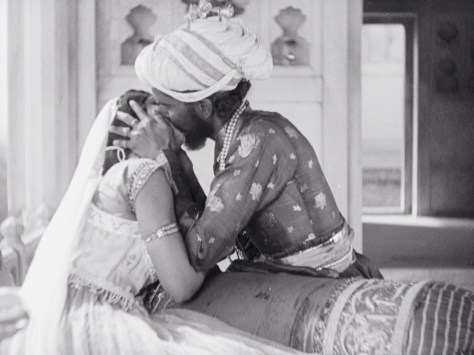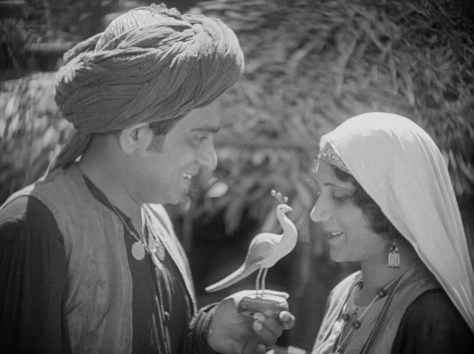Saturday night’s London Film Festival Archive Gala was an extraordinary experience. Regularly a highlight of the silent film year, previous galas have showcased glistening restorations of old and faded movies paired with fresh scores of mostly excellent quality. This year’s event was an exercise in enchanted restoration – with makeover and music transforming a simple film into something entirely wonderful.

Shiraz: A Romance of India was an Indian/British/German co-production from the late silent era. You might know two more films by the director Franz Osten: A Throw of Dice and Light of Asia. Shiraz is a shamelessly romantic and fairly romanticised, telling of the love affair honoured by one the most beautiful mausoleum in the world, the Taj Mahal in Agra.

Shiraz (Himansu Rai, who also produced the film) is a humble, but exceptionally talented potter, who has a deep love for his adopted sister Selima. When Selima (Enakshi Rama Rau) grows up, she is sold as a slave into the royal court and they are separated. What’s more, a love affair slowly begins to spark between Selima and Prince Khurram (Charu Roy) … Meanwhile, general’s daughter Dalia (Seeta Devi) is plotting to get her own hands on the prince.

The story may seem paper-thin, but it has a beautiful surface. The romantic leads are very sweet, with the halting love story between Selima and the Prince always believable and Devi delightfully minxy. The location backdrops of the mountains and palaces are ravishing – a testament to the art direction of Promode Nath and cinematography by Henry Harris and Emil Schünemann that makes the most of natural light.

The action sequence that opens the film, with a caravan raided on its way across the desert, leaving the baby Selima behind, is brilliantly staged. Frequent cuts to her nurse anxiously peeking out at the incoming danger ramp up the tension.There are moments of violence elsewhere too, notably two gruesome threats lobbied at Shiraz himself – the “elephant’s foot” moment caused many in the audience to audibly gasp, and understandably so. It’s a fairly dark story, in truth, with poison, plotting, torture, vengeance, heartbreak and loss on the cards for our group of amorous young things. If you know anything about Indian film, you may be surprised that the lovers share a passionate clinch – and they do.

With such a beautiful film, the restoration work has its chance to shine. Working from an original copy of the film, the BFI has removed scratches, blotches, tremors and flickers, leaving Shiraz unblemished, stable and luminous. Watching the film, simply gazing at it, was a pure pleasure. A fairytale such as this repays the polish.

Performing alongside the film, however, was an ensemble led by Anoushka Shankar playing a sensational new score that she had composed for the film. At this gala, the standing ovation was no mere matter of politeness. Multilayered, pulsing with energy, weaving a selection of Indian and European instruments together with, I think, a foley track, Shankar’s score invigorated the film and hinted at its own “fusion” history as a co-production. Shankar’s sitar playing alone was pretty exceptional, but the score overall was one of the best I have ever heard by a non-specialist.

After its triumphant premiere in London, we can expect to see Shiraz in cinemas and on Blu-ray in January 2018 – I’ll bring you more news on that when I have it. Plus you can catch it, with piano accompaniment by John Sweeney, at the Cambridge Film Festival this month.
The BFI has more ambitious plans for Shiraz though, and both film and score will be embarking on a short Indian tour in November, in partnership with the British Council:
- 1 November: Hyderabad International Convention Centre, Hyderabad
- 3 November: Kala Mandir, Kolkata
- 4 November: Siri Fort Auditorium, New Delhi
- 5 November: Sri Shanmukhananda Chandrasekarendra Saraswathi Auditorium , Mumbai


I sincerely hope that I not only get the opportunity to see this live in the move theater (hint hint SFSFF) and also hope the Blu-ray will have the Shankar scoring. Excellent review, almost feel like I was there, too!
Couldn’t agree more with your review, Pam, it was one of the great silent film evenings. It’s brilliant news that the film and the score are going to screened in cinemas in the new year – while nothing can compare to the impact of hearing Anoushka Shankar’s glorious score live, watching it in a cinema will hopefully reach audiences who might not be into buying Blurays of silent films.
Thanks John. Am sure the Cambridge screening will be very special too.